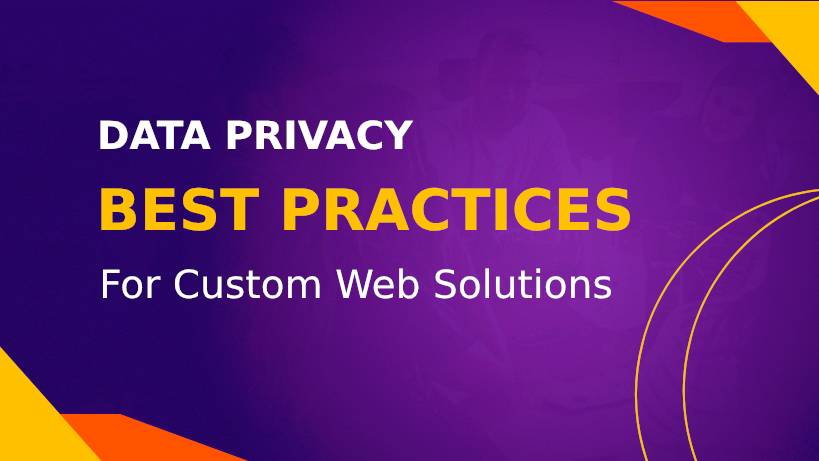
Introduction to GDPR and its Importance for Data Privacy
In today’s digital landscape, data privacy has become a pressing concern for businesses and consumers alike. With the rise of online transactions and personal information sharing, safeguarding sensitive data is more critical than ever. The General Data Protection Regulation (GDPR) stands at the forefront of this movement, setting stringent guidelines to protect user privacy across Europe.
But what does GDPR compliance mean for your custom web solutions? It’s not just about avoiding hefty fines; it’s about building trust with your users. When customers know their data is handled responsibly, they are more likely to engage with your brand. This trust can lead to increased loyalty and a positive reputation in the marketplace.
Navigating GDPR may seem daunting, but implementing best practices can help you stay compliant while providing exceptional service. Let’s explore ten essential strategies that will enhance your approach to data privacy and ensure that your custom web solutions align with GDPR requirements.
Understanding the Key Terms and Concepts of GDPR
GDPR, or the General Data Protection Regulation, is a comprehensive law designed to protect personal data in the European Union. It emphasizes consumer rights and sets strict guidelines for how organizations handle user information.
Key terms like “personal data” refer to any information that can identify an individual. This includes names, email addresses, and even IP addresses.
“Data processing” encompasses any operation performed on personal data. This could mean collecting, storing, or sharing this information with third parties.
Another vital concept is “data subject,” which describes individuals whose data is being processed. They have specific rights under GDPR, including access to their data and the ability to request its deletion.
Understanding these core concepts helps businesses align their practices with GDPR compliance while fostering trust with users about their data privacy and security measures.
Top 10 Data Privacy Best Practices for Custom Web Solutions
Data privacy is critical for any web solution. Implementing best practices ensures GDPR compliance and builds trust with users.
- Prioritize encryption for sensitive data: Protect information during transmission and storage from potential breaches.
- Obtain explicit consent from users: Clear opt-in mechanisms should be in place to inform users of how their information will be used.
- Regularly review your privacy policies and procedures: Keep them up-to-date to address new regulations or vulnerabilities.
- Conduct Privacy Impact Assessments (PIAs): Identify risks associated with personal data processing and mitigate them proactively.
- Train employees on data protection regulations: Knowledgeable staff are essential for maintaining a culture of GDPR compliance.
- Establish a robust response plan for potential data breaches: Preparedness can significantly reduce the impact when incidents occur.
- Minimize data collection: Only collect data necessary for your services, aligning with data privacy principles.
- Implement role-based access controls: Limit access to personal data based on job requirements to enhance security.
- Regularly test and audit security measures: Ensure your custom web solutions remain compliant with GDPR and other regulations.
- Collaborate with GDPR-compliant third-party vendors: Vet third-party providers to ensure their practices align with your data privacy commitments.
Implementing Encryption and Secure Data Storage
Encryption is a cornerstone of data privacy. It transforms sensitive information into unreadable code, protecting it from unauthorized access. For custom web solutions, this means implementing robust encryption protocols during data transmission and storage.
Secure data storage goes hand in hand with encryption. Utilizing secure servers and cloud storage solutions that prioritize security can significantly reduce vulnerabilities. It’s essential to choose providers that comply with GDPR standards.
Regularly updating your encryption methods ensures you stay ahead of potential threats. Cybercriminals are constantly evolving their tactics, so adopting the latest technologies is crucial.
Don’t overlook physical security either. Protecting the hardware where data resides is just as vital as software solutions. This multi-layered approach builds a strong defense against breaches and instills trust among users who value their data privacy.
Obtaining Explicit Consent from Users
Obtaining explicit consent from users is crucial in the realm of data privacy. Under GDPR, it’s not just about asking for permission; it’s about clarity and transparency.
Users must clearly understand what they’re consenting to. This means outlining what type of data will be collected and how it will be used. Avoid vague language that can lead to confusion.
Consent should be given freely and cannot be bundled with other agreements. Ensure that opting out is as easy as opting in. This respects user autonomy while maintaining GDPR compliance.
Regularly review your consent mechanisms to ensure they meet current regulations and best practices. Transparency builds trust, leading to stronger relationships between businesses and users.
Remember, informed users are empowered users, making them more likely to engage positively with your custom web solutions.
Regularly Reviewing and Updating Policies and Procedures
Regularly reviewing and updating policies is essential for maintaining GDPR compliance. The digital landscape evolves rapidly, which means your data privacy measures need to keep pace.
Consider the implications of new technologies or regulatory changes. A policy that was effective last year might become outdated as new threats emerge.
Frequent assessments help identify gaps in your current practices. This proactive approach not only safeguards user data but also builds trust with your clients.
Engaging stakeholders during this process ensures that different perspectives are taken into account. Employees, IT staff, and legal advisors can provide valuable insights into potential weaknesses.
Make it a routine practice to evaluate these policies at least once a year or whenever significant changes occur within your organization. Staying ahead of the curve minimizes risks and reinforces your commitment to data privacy in custom web solutions.
Conducting Privacy Impact Assessments (PIAs)
Conducting Privacy Impact Assessments (PIAs) is essential for any organization seeking GDPR compliance. These assessments help identify potential risks to personal data early in the development of custom web solutions.
The PIA process involves mapping out how personal data flows through your system. This includes understanding what data is collected, where it’s stored, and who has access to it. By doing so, you can pinpoint vulnerabilities before they become issues.
Engaging with stakeholders during this process fosters transparency and collaboration. It invites input from various departments, ensuring that all perspectives are considered.
Regularly scheduled PIAs create a culture of accountability around data privacy within your organization. They also demonstrate a commitment to safeguarding user information—a key factor in building trust with customers.
Proactive assessment aids in aligning strategies with evolving regulations while strengthening overall security measures.
Training Employees on Data Protection Regulations
Training employees on data protection regulations is crucial in fostering a culture of GDPR compliance. When staff understand the importance of data privacy, they are more likely to take it seriously.
Organizing regular workshops and seminars can keep everyone informed about changes in legislation like GDPR. Use real-life scenarios to illustrate potential risks associated with mishandling personal data.
Interactive training sessions encourage engagement, making learning memorable. Gamifying aspects of the training can also spark interest and improve retention rates.
Documenting attendance and understanding through quizzes ensures accountability. Empower your team by providing them with resources they can refer back to when needed.
Encouraging open discussions around data privacy allows employees to voice concerns or seek clarification. This collaborative approach builds trust while reinforcing the organization’s commitment to protecting sensitive information.
Establishing a Data Breach Response Plan
Establishing a data breach response plan is essential for any organization prioritizing data privacy. A well-crafted plan ensures that you’re ready to act swiftly and efficiently in the event of a breach. This not only helps mitigate damage but also reinforces trust with your users.
Start by outlining clear roles and responsibilities within your team. Designate who will communicate with affected parties, legal advisors, and regulatory bodies. Time is of the essence during a data breach; having designated personnel allows for swift action without confusion.
Your response plan should include steps for identifying the scope of the breach, assessing its impact, and implementing immediate containment measures. Document every action taken throughout this process. Transparency plays a key role in maintaining user trust.
Regularly testing this response strategy through simulations can help identify weaknesses in your approach. Update it as needed based on these tests or changes in regulations related to GDPR compliance.
By establishing an effective data breach response plan, you're not just complying with GDPR – you're demonstrating commitment to robust data privacy practices that protect both your organization and its users from potential harm.
At AnchorPoints, we prioritize data privacy and security in every custom web solution. Ensure your business stays GDPR-compliant with our expert guidance and secure development practices. Contact us today to safeguard your users’ data and build trust with your audience! 🚀🔒



